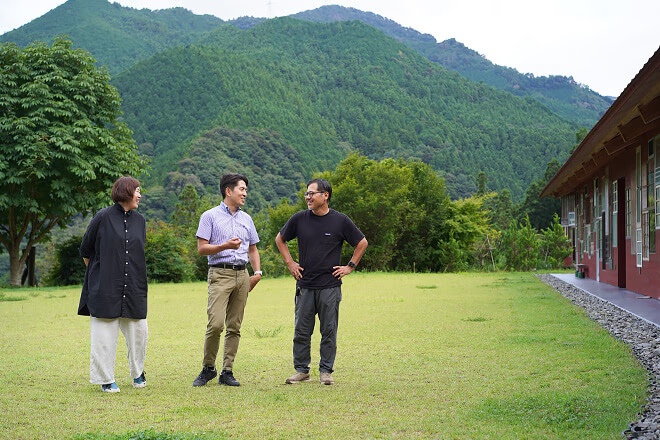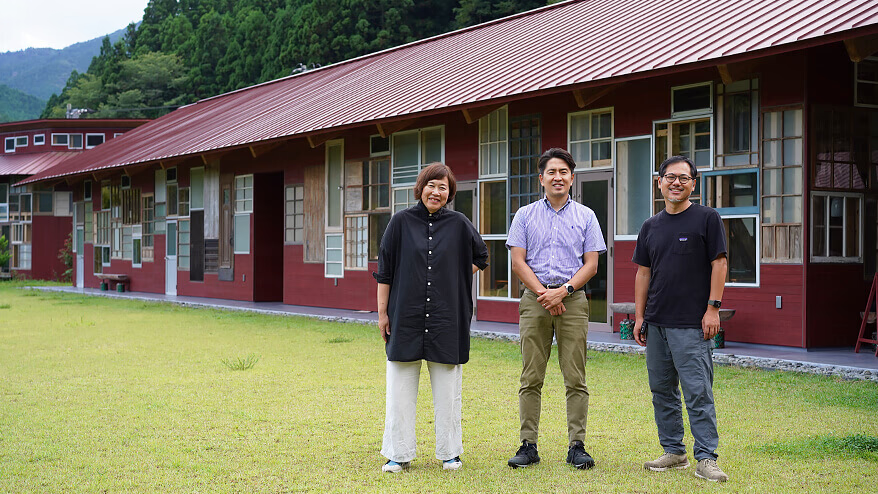2021年9月にリニューアルされた高津紙器のコーポレートサイトを開くと、トップページに現れたのは、『高津社長のサステナ見聞録』という連載。食品・衛生品対応の紙管・紙パッケージ・紙トレー専門の製造会社を営む社長が、「プラスチックよりも紙」という風潮のなかで「紙だから環境に良いと言って良いものか」と悩み、「自ら見て聞いて、感じて学んだことを発信する」という内容です。1回目の記事では、徳島・上勝町のゼロ・ウエイストセンターWHYを訪ねるようすが綴られていました。
「ものすごく正直なコンテンツだな……」
と、衝撃を受けたことを覚えています。個人でも企業でも、人前に出るときは「より良く見られたい」と思うのは当然で、わかっていないことでもわかっているフリをしたくなるものだと思います。「悩んでいます」「わからないから考えています」と話している高津社長のたたずまいに、まぶしさすら感じました。
この気持ちのいいコーポレートサイトが、どんなふうにつくられたのか聞いてみたいーーと思いはじめて約半年。プロジェクトメンバーが上勝町に集まる機会に、座談会形式でお話を聞かせていただきました。写真撮影はデザイナーの滝田怜子さんです(以下、敬称略)。
座談会参加者
高津俊一郎さん(高津紙器株式会社 代表取締役)
明治15年に「日本一の紙のまち」四国中央市川之江町で創業した紙加工会社・高津紙器を2019年に継業。モノサスの林、リニューアルしたコーポレート・サイトでは連載「サステナ見聞録」でSDGsやゼロ・ウェイストについて見聞を広めている。
https://www.kozushiki.co.jp/
赤池円さん(有限会社グラム・デザイン 代表)
本業でWebサイトのプランニング、デザイン、プログラム開発などを手がける傍ら、主に環境・森林・地域・教育分野の情報発信の支援やプロジェクトの仕組みづくりなどにも参画。『私の森.jp』編集長。本プロジェクトでは、プランニングとデザインを担当。
https://www.gram.co.jp/
林隆宏(株式会社モノサス 代表取締役社長)
大学卒業後、大手コンサルティング会社で働いたのち転職。2005年、モノサスの前身となる会社を立ち上げる。本プロジェクトではプランニングを担当。
林隆宏が書いた記事>
周囲の会社を見る目が変わり、社員のモチベーションが上がった
―― 連載『サステナ見聞録』を読んですごくいいなと思っていました。すごく正直に語り合っておられて、「環境対応どうしよう?」と気になっている、中小企業の方たちにも共感されるのではないかと思ったんです。リニューアル以降、どんな反響がありましたか?
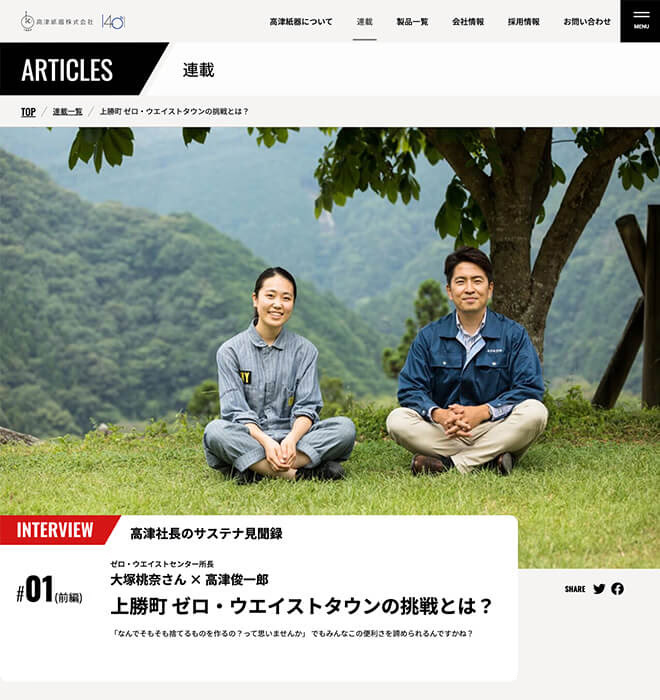
高津 「まさか!」と思うようなことがどんどん起きています。全国から「面白いことをやっている会社だよね」という目で見られるようになりました。問い合わせフォームを通じて、大手企業から引き合いがあり、すでにいくつかの案件が決まっています。実を言うと、モノサスから見積りをもらったときは「高い!」と思っていたんです。林さんに「損はさせない。絶対に返ってくるから」と言われたのですが、本当だったなと思っています。
今回、林さんと赤池さんに高津紙器の強みを知ってもらい、リニューアルの提案をいただいて初めて、社長である僕自身がやっと自社の強みを理解しました。そして、その強みを発信したことによって、社員も自分たちの強みに気づき、社会からの反響によってまた我々が「ほんとやね」と再認識できました。
―― 「ABOUT」のコピー「清潔さを、まきとる・つつむ・のせる。」も秀逸だなと思いました。何をしている会社なのかを一目でイメージできました。
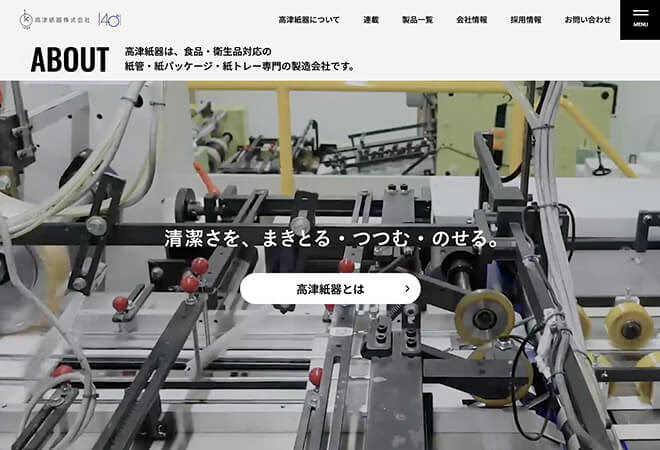
高津 林さんが考えてくれたのですが、うまいですよね。やっぱりコンサルタントの感性ですね。名刺にも入れるようにしました。
赤池 前のWebサイトには「何をしている会社なのか」がストレートに伝わる言葉がなくて。「ABOUTのページがあったほうがいい」と言ったら、林さんが「じゃあ書くよ」と受け止めてくれました。ある日、私たちが工場の撮影をして戻ってきたら、「わかったよ、赤池さん!」って、このコピーが出てきました。
林 高津さんは、自社や自社の製品の強みに気づいていない感じが伝わってきていて、何度ヒアリングしても高津紙器の良さを捉えきれなかったんですね。だけど、自分が本当にいいと思う会社でないと、コピーを書くことはできません。だからこそ、「やっとわかった!」と思えたとき、すごくうれしかった。同時に、その瞬間まで彼の会社や製品のすばらしさに自分が向き合えていなかったことを反省しました。もし気づかないままつくっていたら、いいWebサイトをつくれていなかったと思います。
クリエイティビティと生産性のせめぎ合いのなかで
―― 今回のプロジェクトは、林さんと赤池さんがプランニング、デザインはグラム・デザイン、全体のディレクションとコーディングはモノサスという制作体制で進められたそうですね。
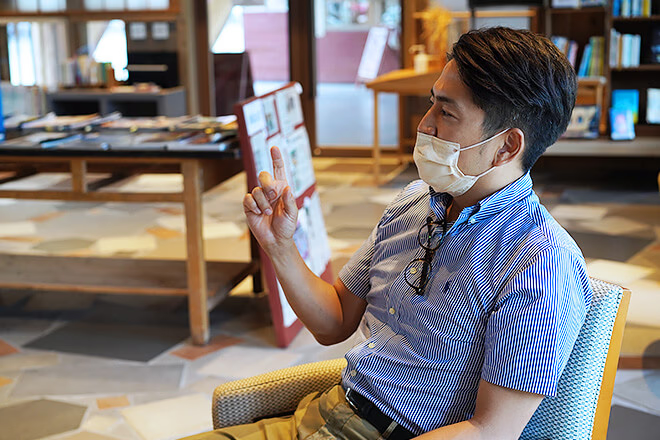
高津紙器・高津俊一郎さん
高津 ディレクターの永井さんがまたいいんですよ。しっかりしていて穏やかで、プロ中のプロという感じですごく安心できました。
赤池 工程管理をしっかり見てディレクションしてくださるから、外部の私たちも安心して進められました。
―― 役割分担について、もう少し細かく聞いてみたいです。
林 本来は、複数の職掌をもつ人たちが議論しながら、並列的に進めたほうがすごくクリエイティブなものができます。でも、プロジェクトメンバーがすべての打ち合わせに出ていると生産性が下がってしまいます。なので、工程ごとに役割を分担してウォーターフォールモデルで開発を進めていくのですが、そうすると例えばコーダーは発注者の熱い思いを直接聞く機会をもてません。上流工程から出た指示を信号として受け取って作業してしまうと、ものづくりとしてクリエイティブになりきれません。
ところが今回、グラム・デザインさんとは、ずっと一緒に議論しながらものをつくることができました。ほどよく役割分担しながら、生産性とクオリティが同時に高まっていく方向にきちんとつながっている感覚もあって、すごくよかったなと思っています。
―― 今のお話を、赤池さんはどんなふうに聞いていましたか?
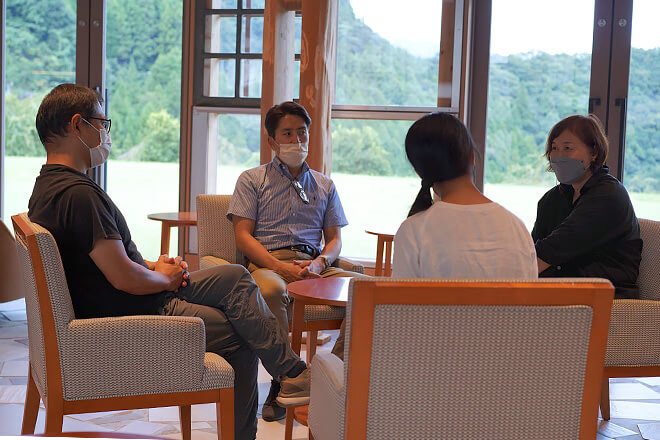
グラム・デザイン 赤池円さん(右)
赤池 私たちも「林さん、上手だな!」と思いながら関わらせてもらっていました。「これをやりなさい」と締めるのではなく、てきとうに野放しにしておいてくれて。私たちができることを提案すると、うまく入る場所をお互いに見つける感じがありました。何かを決めるときも、お互いに腑に落ちる段階がわかる感じもあり、すごくやりやすかったです。
林 僕は、ある程度プレイヤーにならないと力を発揮できないところがあります。一人称で文章を書こうとしたときにはじめて開く回路があって、ディレクションだけだとそこが開かない。ただ、僕の場合は、結果を決める部分に対する集中が深いから、全部を自分でやりきろうとするとガス欠を起こしてしまう。だからといって、役割分担するといいものができないというせめぎ合いが常にあって、なかなか僕が案件に入れない時期がありました。今回は、グラム・デザインと協業したことですごくいいバランスが取れましたし、永井さんが最後までちゃんと面倒を見てくれた。そこの橋渡しがうまくいった感覚があります。
赤池 もうひとつ、私にとってこのプロジェクトがすごくよかったのは、上勝で「サステナ見聞録」の最初のインタビューをしたときに、中小企業の人たちが環境問題に関わっていく姿勢や意味をすごく考えさせられたことです。これは、高津さんの正直な質問とWHYの大塚さんの若々しい対話のなかにあって。聞いていてワクワクしたし、すごく意味があるなあと思えました。
いわゆるCSRというテーマでは、「社会に対して貢献できることをアピールする」お手伝いをすることが多いのですが、今回のように、サステナビリティに照らして、自社事業そのものを問い直す、という場面に立ち会うのは初めてになります。「何をPRするか」は置いておいて、「何をするか」の方が社会的に影響力があると確認できたんですね。すごく手応えのある仕事だったと思っています。
高津さんの正直さをありのままに表現する
―― ところで、高津さんはどうしてコーポレートサイトのリニューアルをモノサスに依頼しようと思ったんですか?
高津 彼とは高校の同級生で、会社を立ち上げていることは知っていました。しかも、やはり同級生だった真鍋くんや山内くんも一緒に働いています。友だちと会社をやれるなんて、いい経営者なんだろうし、他の社員のみなさんもいい雰囲気でした。きっといい仕事をするんだろうなと思っていたんですよ。もうひとつは、地元の会社に依頼して無難なWebサイトをつくりたくはなくて、「他社とは違うWebサイトをつくってほしい」とお願いしました。
―― 高津さんの依頼を受けて、林さんはどう応えたんですか?
林 やんわり断りました(笑)。こういうふわっとした案件はメンバーに任せられないし、自分でやるしかなくなりますから。すると、しばらくしたらまたお願いされて、「じゃあ、やるか」となりました。
高津 「他社と違うことをやりたい」と相談すると、彼はじっくり聞いていろんな提案をくれました。そのなかで「ものさすサイトのように、対談やコラムを載せるはどう?」って言われました。「いや、うちなんか業務用製品だし書くことないよ」と答えたら、「いやいや、あるんじゃない?」といろいろ引き出してくれたんです。
―― そこで、環境問題やSDGsというテーマが出てきた。
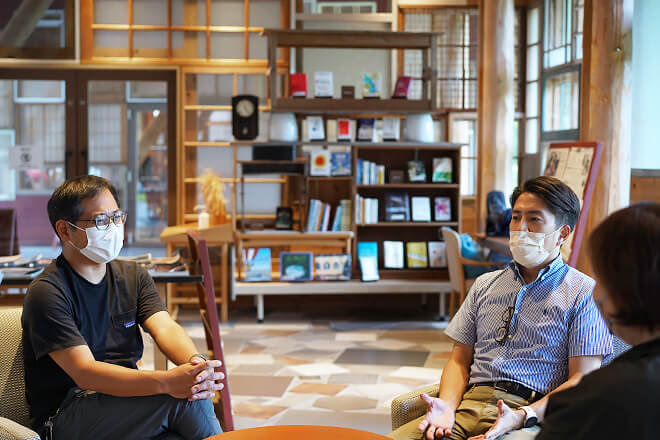
モノサス・林隆宏(左)
林 近年、環境への配慮からプラスチックトレーを紙トレーに変える流れがあるので、「環境対応の部分を謳いたい」という話があったんですよね。
―― そこで、環境分野の情報発信を手掛けてきたグラム・デザインさんに声をかけたんですね。
赤池 本格的な協業は今回が初めてでしたが、モノサスのことはずっと前から知っていました。コーディング・ファクトリー(CF)に仕事をお願いして以降CFの冊子が送られてくるのですが、「いい会社になっていくんだな」という感じも伝わっていました。断る理由は何もなかったです。
高津 赤池さんもすごく話を聞くのが上手なんです。僕が「SDGsなんて興味ない」「ヨーロッパの戦略だ」と、否定的なことを言うと「面白いですね。そういう正直なところがいい」と受け入れてくれて、「その正直さを出していきましょう」と言ってくれました。
赤池 実際にEUの方針によって日本が不利な立場になることはあるので、経営者としてはそこに腹が立っているんだろうな、と。高津さんのお話を聞いた後、林さんと確認しあったのは「正直な人だね」という印象でした。そこで、林さんと話して高津さんが勉強していくプロセスをコンテンツにしようということになって、「サステナ見聞録」につながりました。
林 「サステナ見聞録」は、「40代の何もわかっていないおじさんが、20代の女の子に叱られに行って、気づいたことをもとに本当に勉強を始める」というコンセプトで企画しました。SDGsを推進する段階に至っていないのに、「高津紙器はSDGsに取り組んでいます」とは僕らは絶対に書けません。コーポレートサイトで嘘を書くとみんなが不幸になります。嘘から発生した仕事に社員は対応できないし、お客さんも不幸になってしまいますからね。
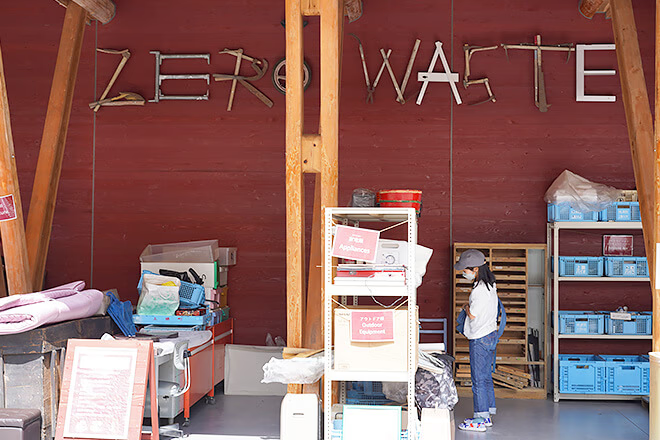
上勝町のごみ分別は13種類45分別。ごみ収集車はなく、ゼロ・ウェイストセンター内の「ごみステーション」に持ち込まれる(生ゴミは各家などで堆肥化)。
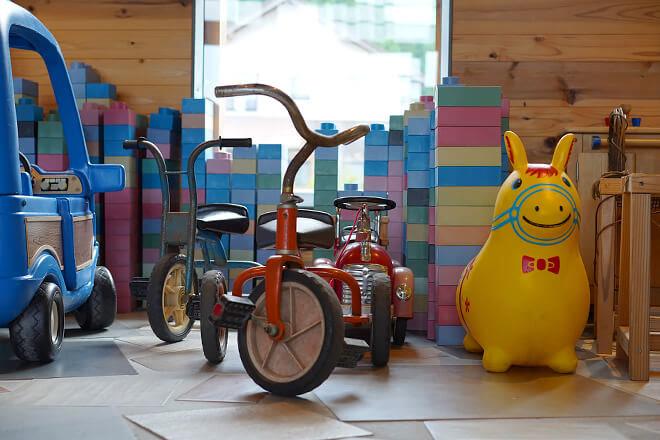
まだ使えるものは、同じくゼロ・ウェイストセンター内の「くるくるショップ」(町民のみ持ち込み可)へ。誰でも持ち帰ることができます。
改めて、コーポレートサイトの役割を考えた。
―― リニューアルから約1年が経ってふたたび上勝を訪問されたのは、高津紙器が会社を構える四国中央市の紙業会社のみなさんと一緒にワークショップをするためだったそうですね。
林 当初は「サステナ見聞録」で、テンポよくいろんな地域を訪問しようと考えていましたが、1回目の上勝がかなり濃かったので「このレベルのものはそうそうできないね」ということになって。そのとき、赤池さんから「まずは1年くらい、上勝ときちんとつきあった方がいいんじゃないですか」と言ってもらいました。「学んだことを上勝に返しに来ることができたらいいね」「上勝との関係性をつないでいけるといいね」という方向にプランが変わったんです。
赤池 前回上勝に来たとき、大塚さんの「生産者のみなさんに思いが伝わらない」というお話に対して、高津さんが「同業者の社長を連れて来られるよ」と応えていたんですね。そういうやりとりから、WHYで新しいことができたり、生産者である高津さんたちの会社で商品開発が始まったりしたら、本当にすばらしいじゃないですか。インタビューだけに終わらずに、次につながっていったらいいなと思いました。
高津 あの記事を読んだ何人もの人たちに、「上勝に紹介してほしい」と言われました。でも、今回は「行きたい」と思っている人ではなく、あえて自分と同じようにちょっと斜に構えているメンバーを連れて来ました。僕たちのビジネスの基本は大量生産・大量消費ですが、そればかりではやっぱりダメです。今回は、ちゃんと考えるいい機会になったし、みんな絶対に行動を起こすと思います。また、その後のことを大塚さんに報告できそうですね。
―― 最後に、今回のプロジェクトを振り返りながら、改めてみなさんが考える「コーポレートサイトの役割とは何か」を聞いてみたいです。
高津 僕自身が、自社を客観的に評価できていなくて、ずっと「何が強みなんだろう……」と思っていました。今回のリニューアルを通して、自分の会社を再発見することができました。中小企業の経営者にたくさん会いますが、たいていはコーポレートサイトに力を入れていません。「うちは決まった取引先があるから情報発信の必要はない」という人が多い。でも、ちゃんと発信すれば絶対に何か返ってくると思います。
赤池 コーポレートサイトはたくさんつくってきましたが、いつも気をつけているのは「似合わない服は着せない」ということ。だけど、ちょっと自信をもって着れる服を着せたいと思っていて、今回はそれができたという実感があります。とてもいいお仕事をさせてもらいました。
高津 いい言葉ですね、感動しました。うちにも当てはまりそうです。
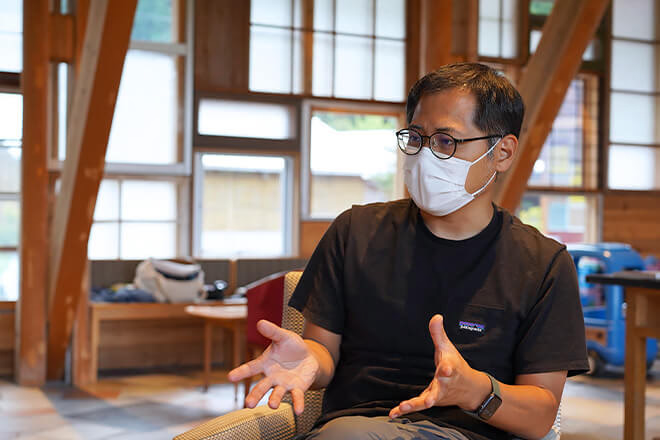
林 コーポレートサイトは、僕らがつくりたいものをつくるわけではないし、クライアントがつくってほしいものをつくるのでもなく、「つくられていくもの」なんですね。一緒に掘り出していく作業をしていくなかで生まれてくるものだと思うんですよ。そういうバランスを崩れないようにしたいと強く思っています。
もうひとつ、コーポレートサイトは会社と一緒に変化できるメディアです。社員のみんなと一緒に成長していくためのエンジンにも、写し身にもなれる可能性があるんです。だから、その会社の中にいる人たちに向けて、コーポレートサイトをつくっているという意識もあります。高津さんが話してくれたように、コーポレートサイトをつくったことによる反響があり、それによって社員のモチベーションが上がって、また社会との関わりが変わっていく。そういうやりとりができる可能性のあるメディアだと思っています。
―― ありがとうございました。これからも高津紙器のコーポレートサイトがどんなふうに育っていくのか楽しみにしています。
